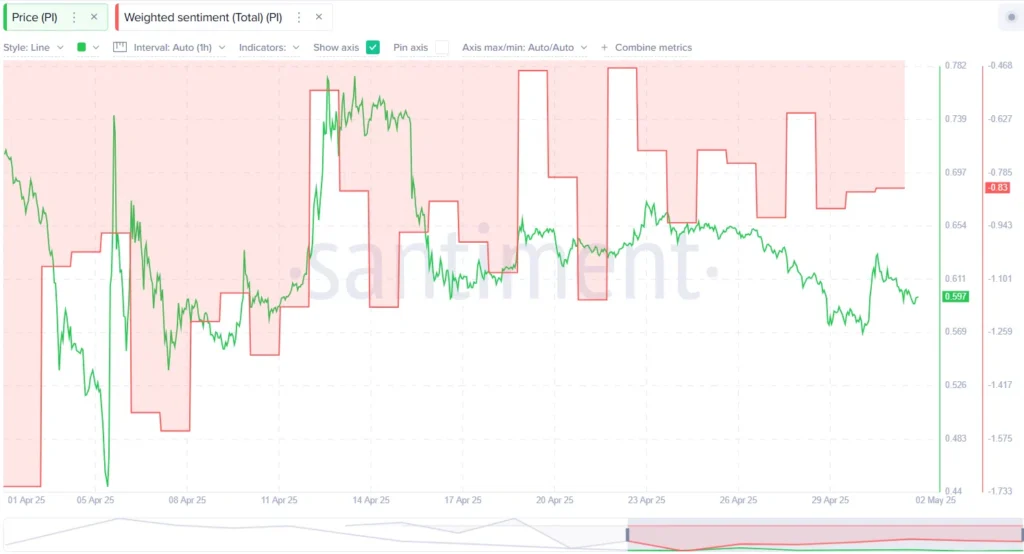- PI Drops Below $0.60 amid dilution fears and bearish technical signals.
- Ecosystem Expands with new dApps, Pi Ad Network, and real-world adoption events.
- Binance Listing Hopes could spark price recovery and renewed investor interest.
Pi Network’s native token, PI, continued its downward trend in early May after failing to maintain above a crucial $0.60 support level, amid the emergence of bearish technical indicators and fears of token dilution.
PI was trading at $0.59 at press time, a roughly 10% drop in the last half-week. Looking toward the broader market trend, the token’s PI is having a tough time, shedding over 23% of its value and nearly 80% below its all-time peak of $2.99, which was recorded late February.
Pi Network market capitalization was $4.1 billion, and daily trading volume has decreased by over 40% to nearly $75 million. Market analysts say the markets have been under such selling pressure because of fears of token dilution. Around $12.3 million worth of PI tokens were unlocked in April alone, or some 21.4 million of those tokens. The level of this unlocking event is relatively small, but it raised investor anxiety as the rest of the unlocks coming in the next several months are significantly larger.
The token supply is projected to increase steadily, with monthly unlocks on average expected to be above 131 million PI in the next year. However, if demand does not increase in the same proportion, there could be considerable downward pressure.
Despite Price Slump, Pi Ecosystem Sees Continued Expansion
PI’s market performance has run dry, but developments in the Pi Network ecosystem suggest a possibility of interest and community engagement returning to Pi. Coming soon after launching the open mainnet, developers are working to bring the creation of utility-based decentralized (dApps) applications as a significant part of bringing Pi in front of the actual digital market.
The notable platforms within the ecosystem are 1Pi Mall, Pi exclusive E-commerce marketplace, Workforce Pool (Pi freelancing hub) and Map of Pi to help users search and interact with Pi-compliant businesses. On the flip side, Pi Network had already gone beyond what it aimed to achieve in 100 dApps before the Open Mainnet launch, and the news has continued with the addition of Piepump.fun, a memecoin launcher equivalent to Solana’s Pump.fun and Fruity Pie, a pie game with rewards.
This is where the Pi Ad Network came in. This feature in the Pi Network enables advertisers to pay for promotional space in the token (PI), and app developers will earn PI by showing the ads. It also brings about an ultimate closed-loop monetary technique, where Pi is used to pay and make money inside the network, decreasing third-party advertising options like Google Ads.
Further, .pi domains make available the rollout of personalized blockchain-based domain names that you can bid for in Pi Coin. These domains aim to get .pinet.com domains working via the Pi Browser or at .pinet.com to enhance the network’s internal identity system. The proceeds are expected to support the ongoing ecosystem growth initiatives.
In real-world engagement, Pi Network has quickly driven adoption with grassroots events like PiFest or merchant onboarding campaigns. More than 58,000 active sellers from 162 countries showed up at the 2025 PiFest, held from March 14 to 21. During the event, Pi-powered transactions reportedly involved more than 1.8 million users, often using the Map of Pi app to look up participating businesses.
Potential Exchange Listings Could Fuel a Price Recovery
A listing on Binance, the world’s largest crypto exchange in terms of volume, could give Pi Network PI Token Slides Below $0.60 as Bearish Pressure Mounts Amid Unlock Concerns much-needed boosts to its price and visibility. The token is now live on most centralized platforms such as OKX, Bitget, and MEXC, but not on Binance.
Binance held a community vote last year in 2025 to determine whether to list PI in spot form, and 87.7% of around 295,000 users voted in favor of a spot listing of PI. Past Binance listings have shown that listed assets have historically correlated with increased liquidity, trading volume, and investor interest. Analysts predict that Binance will be followed if PI secures a spot there by other top exchanges such as Coinbase, Crypto.com, Kraken, and Upbit.
Technical Analysis Signals Persistent Bearish Momentum
From a technical point of view, PI’s price outlook is bearish. The token is now trading below both the 20 and 50-day exponential moving averages on the 1-day / USDT chart, which confirms bearish sentiment to operate in the short and medium term market structure.
The Relative Strength Index (RSI) has slipped below the neutral marker at 50 and is close to crossing the oversold level. Also, the MACD (Moving Average Convergence Divergence) indicator is at the waning momentum point. Despite how tight the gap has closed, the MACD line still hangs over the signal line, and that gap can suggest a bearish crossover.
If PI is supposed to regain bullish momentum, then it has to break above $1, which acts as the psychological resistance level. The move above $0.645, which marks the superposition of the upper boundary of a descending trendline from April 5, might act as a catalyst to a pullback to $0.81 to $1, depending on a rise in trading volume, said one trader.
Conversely, the falling price may revisit the $0.57 support level and spark a wave of selling pressure that could push the coin down to $0.40 and below. So, as long as Pi Network continues to have a community-centric model, social sentiment will continue to play a leading role in its market trajectory. Sentiment is currently negative, given recent data provided by analytics platform Santiment.

As of press time, PI was trading at $0.59 per token against a 24 hour decline of 3%, while extensions of its short term losses resulted from broader market uncertainty about the near term future of the project.














